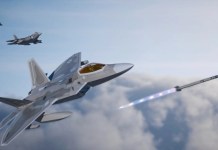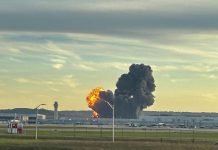With the United States continuing to block any and all attempts of China’s indefinite maritime expansion in the South China Sea, it is revealed that Beijing’s activities in the region are being kept under direct surveillance by American Warship Hunter, the E-8 Radar aircraft.
Is The Indian Air Force A Potential Buyer For The New Russian Super Sukhoi Fighter Jets?
The U.S. Air Force’s tank-tracking ground-surveillance plane, the Northrop Grumman E-8 Joint STARS (JSTARS) has been seen, flying circles over the western Pacific south of Taiwan. It has also been spotted nearly 100 miles from the Chinese coast, close enough to spot PLA warships, in the region (South China Sea).
The four-engine E-8 JSTARS is a Boeing 707 equipped with an underslung AN/APY-7 synthetic aperture radar which includes the “Ground Moving Target Indicator (GMTI)” function, which can spot vehicles in motion, and show operators where the vehicle has been and where it will head.
The GMTI function not only enables it to scan targets on the land but at the sea as well, by scanning 200 square miles at a time, and has earlier been deployed in the Caribbean to spot drug-running boats. The Pentagon understands that its forces can make much use of the radar and computer subsystems on the E-8C, to scan, detect and gather detailed information of Chinese warships at sea.
The US and China have been at loggerheads with each other in the South China Sea region, with the Pentagon deciding to send warships and aircraft carriers into the region with increasing frequency, even when the US Navy was struggling to deal with multiple Coronavirus outbreaks.

China, which claims a historic right of ownership to almost the entire South China Sea, despite a 2016 international arbitration ruling refuting China’s claims under international law, has faced retaliation from the Trump administration, who has been aggressively partnering with nations like Taiwan, Japan and South Korea to counter Beijing.
Although used for detecting armored vehicles in a desert, the E-8 JSTARS are being increasingly used to detect warships in the region. There have been a fair number of JSTARS currently operating from the Air Force mega-base in Okinawa, Japan.
It is speculated that since China’s decision to launch two missiles as a warning signal to the US Forces in the region, Trump has increased deployments of his own, alongside Taiwanese fighter planes and drones to outlying islands in the region.
The US have deployed the E-8 alongside US Navy’s new P-8 patrol plane, with the former scanning the waters and the latter descending low to inspect targets visually.
“We used the complementary strengths of JSTARS and the P-8 to positively identify maritime vessels over a large area of responsibility and determine whether they were friendly, enemy or neutral,” said Lieutenant Colonel Victor Ellis, an Air Force liaison officer.
Developed on the model of the highly adaptable civilian 707-200 commercial airliner airframe, the E-8C Joint Surveillance Target Attack Radar System has served as the US Air Force’s primary alternative for battle management and for tracking ground targets.
Currently, the US Air Forces possess around 17 JSTARS, which are famous for serving in the 1991 Gulf War by helping allied forces to track hundreds of Iraqi tanks in the desert and destroying them.




